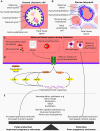Maternal-Fetal Conflict During Infection: Lessons From a Mouse Model of Placental Malaria
- PMID: 31178840
- PMCID: PMC6542978
- DOI: 10.3389/fmicb.2019.01126
Maternal-Fetal Conflict During Infection: Lessons From a Mouse Model of Placental Malaria
Abstract
Infections that reach the placenta via maternal blood can target the fetal-placental barrier and are associated with reduced birth weight, increased stillbirth, miscarriage and perinatal mortality. Malaria during pregnancy can lead to infection of the placental tissue and to adverse effects on the unborn child even if the parasite is successfully cleared, indicating that placental sufficiency is significantly compromised. Human samples and animal models of placental malaria have been used to unravel mechanisms contributing to this insufficiency and have implicated molecular pathways related to inflammation, innate immunity and nutrient transport. Remarkably, fetal TLR4 was found to take part in placental responses that protect the fetus, in contrast to maternal TLR4 responses that presumably preserve the mother's health but result in reduced fetal viability. We propose that this conflict of fetal and maternal responses is a determinant of the clinical outcomes of placental malaria and that fetally derived trophoblasts are on the front lines of this conflict.
Keywords: malaria; maternal-fetal conflict; placenta; pregnancy; toll-like receptors.
Figures

Similar articles
-
TLR4-Endothelin Axis Controls Syncytiotrophoblast Motility and Confers Fetal Protection in Placental Malaria.Infect Immun. 2021 Jul 15;89(8):e0080920. doi: 10.1128/IAI.00809-20. Epub 2021 Jul 15. Infect Immun. 2021. PMID: 34061587 Free PMC article.
-
Fetal and Maternal Innate Immunity Receptors Have Opposing Effects on the Severity of Experimental Malaria in Pregnancy: Beneficial Roles for Fetus-Derived Toll-Like Receptor 4 and Type I Interferon Receptor 1.Infect Immun. 2018 Apr 23;86(5):e00708-17. doi: 10.1128/IAI.00708-17. Print 2018 May. Infect Immun. 2018. PMID: 29440369 Free PMC article.
-
Causal relationship between obesity-related traits and TLR4-driven responses at the maternal-fetal interface.Diabetologia. 2016 Nov;59(11):2459-2466. doi: 10.1007/s00125-016-4073-6. Epub 2016 Aug 17. Diabetologia. 2016. PMID: 27535280 Free PMC article.
-
Genetic conflicts in human pregnancy.Q Rev Biol. 1993 Dec;68(4):495-532. doi: 10.1086/418300. Q Rev Biol. 1993. PMID: 8115596 Review.
-
The Impact of Infection in Pregnancy on Placental Vascular Development and Adverse Birth Outcomes.Front Microbiol. 2019 Aug 22;10:1924. doi: 10.3389/fmicb.2019.01924. eCollection 2019. Front Microbiol. 2019. PMID: 31507551 Free PMC article. Review.
Cited by
-
Potential pharmacologic interventions targeting TLR signaling in placental malaria.Trends Parasitol. 2022 Jul;38(7):513-524. doi: 10.1016/j.pt.2022.04.002. Epub 2022 May 7. Trends Parasitol. 2022. PMID: 35537977 Free PMC article. Review.
-
Self-assembled human placental model from trophoblast stem cells in a dynamic organ-on-a-chip system.Cell Prolif. 2023 May;56(5):e13469. doi: 10.1111/cpr.13469. Epub 2023 May 17. Cell Prolif. 2023. PMID: 37199016 Free PMC article.
-
Imported severe Plasmodium falciparum infection in the first trimester of pregnancy complicated by post-artemisinin delayed hemolysis and intrauterine fetal death, a case report.Trop Med Health. 2023 May 12;51(1):25. doi: 10.1186/s41182-023-00510-2. Trop Med Health. 2023. PMID: 37170175 Free PMC article.
-
Prevalence of Malaria and Associated Factors among Delivering Mothers in Northwest Ethiopia.Biomed Res Int. 2021 Dec 7;2021:2754407. doi: 10.1155/2021/2754407. eCollection 2021. Biomed Res Int. 2021. PMID: 34917681 Free PMC article.
-
TLR4-Endothelin Axis Controls Syncytiotrophoblast Motility and Confers Fetal Protection in Placental Malaria.Infect Immun. 2021 Jul 15;89(8):e0080920. doi: 10.1128/IAI.00809-20. Epub 2021 Jul 15. Infect Immun. 2021. PMID: 34061587 Free PMC article.
References
LinkOut - more resources
Full Text Sources

